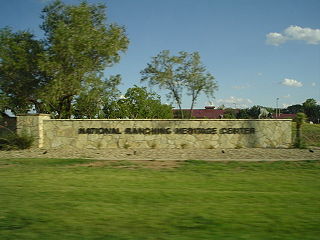
The U Lazy S Ranch, formerly known as the Square and Compass Ranch, is a historic ranch in Garza County, Texas, USA.

The U Lazy S Ranch, formerly known as the Square and Compass Ranch, is a historic ranch in Garza County, Texas, USA.
The ranch was established as the Square and Compass Ranch in 1884. [1] [2]
By 1901, when it was acquired by John Bunyan Slaughter, the ranch spanned 99,188 acres. [2] [3] Slaughter also purchased 5,000 cattle and brought 6,000 head of cattle he already owned. [3] Additionally, he changed the name to his cattle brand, 'U Lazy S', which he had registered during the American Civil War. [4] He built a ranchhouse in 1902 and acquired more acres, owning up to 126,227 acres a few years later. [2] [4] In 1906, he sold 50,000 acres to C. W. Post, who founded the new town of Post, Texas. [3] [4]
In 1928, the ranch was inherited by Slaughter's son, John B. Slaughter, Jr., who was educated at the Phillips Exeter Academy and Yale University. [5] According to historian William Curry Holden, "By 1936, 8,000 Hereford cattle grazed 100,000 acres of U Lazy S land." [4] The ranchhouse, a designated Texas landmark, burned down on January 13, 1936. [6] [7] [8]
The ranch was inherited by his nephew, John F. Lott and his niece, Mary Belle Lott Macy, in 1940. [4] Lott split some of the acreage into farms. [4] In 1949, Lott started flying an airplane to drive the cattle and spray herbicide. [4]
In the 1950s, the land was faced with a draught. [9] By 1954, Lott planted 1,400 acres of guar to improve the land. [10] He was also the first Texas rancher to use a roto-pitter to break up the rangeland. [11] Two years later, in 1956, Lott's range improvement program had worked. [9]
In 1965, Macy split her section of the ranch and renamed it the Running M Ranch. [4] Meanwhile, the U Lazy S Ranch was managed by Lott's son, Jack Lott. [4] By 1966, the ranch spanned 90,000 acres. [3]
In October 1968, Lott and his wife hosted François Tombalbaye, the President of Chad, on his official visit to Texas. [12] A year later, in 1969, they donated $10,000 [U.S. dollars], plus a carriage house from the ranch to the National Ranching Heritage Center in Lubbock, Texas. [3] [13] In 1973, a fundraiser for the public library in Post, Texas was held on the ranch. [14]

Sterling County is a county located on the Edwards Plateau in the U.S. state of Texas. As of the 2010 census, its population was 1,143, making it the ninth-least populous county in Texas. Its county seat is Sterling City. The county is named for W. S. Sterling, an early settler in the area. Sterling County was one of 30 prohibition, or entirely dry, counties in the state of Texas, but is now a moist county.

Garza County is a county located in the U.S. state of Texas. As of the 2010 census, its population was 6,461. Its county seat is Post. The county was created in 1876 and later organized in 1907. Garza is named for a pioneer Bexar County family, as it was once a part of that county. It is located southeast of Lubbock.

The National Ranching Heritage Center, a museum of ranching history, is located on the campus of Texas Tech University in Lubbock, Texas. The NRHC features almost fifty authentic ranch buildings dating from the late 18th to the mid-20th century. These structures include a railroad depot, homesteads, barn, blacksmith shop, schoolhouse, windmills and other historic structures. One views the exhibits through a self-guided walking tour. It is free to the public.

Lubbock Avalanche-Journal is a newspaper based in Lubbock, Texas, United States. It is owned by Gannett.

KFYO is a Lubbock, Texas, based news/talk radio station operating on 790 kHz AM, owned by Townsquare Media. Its studios and transmitters are located in southwest Lubbock.

The 1947 Texas Tech Red Raiders football team was an American football team that represented Texas Technological College as a member of the Border Conference during the 1947 college football season. In its seventh season under head coach Dell Morgan, the team compiled a 6–5 record, lost to Miami (OH) in the 1948 Sun Bowl, and outscored all opponents by a total of 228 to 184.
Ira P. DeLoache (1879-1965) was an American real estate developer. He was the founder of Whiteface, Texas. He was the main developer Preston Hollow, an upper-middle-class neighborhood in Dallas, Texas.
Christopher Columbus Slaughter (1837–1919) was an American rancher, cattle drover and breeder, banker and philanthropist in the Old West. After serving in the Confederate States Army during the American Civil War of 1861–1865, he came to own 40,000 cattle and over one million acres of ranch land in West Texas. He became the largest taxpayer in Texas, and used his wealth to endow Baptist institutions. He was known as the "Cattle King of Texas."
The Mallet Ranch is a historic ranch in Texas. It was established in Hockley County, Texas in the 1880s. It was used to raise Hereford cattle from the 1900s to the 1930s, with cotton fields added in the mid-1920s. By the late 1930s, oil was discovered. The ranch spanned 45,000 acres in 1990.
The Texas Conference was a college athletic conference in the United States that existed from 1926 to 1956. During its existence, a total of 11 different colleges in Texas, and one from New Mexico, were members.
Robert Lee Slaughter (1870-1938) was an American rancher and oilman. He was the owner of ranches in Texas, USA and Sonora, Mexico.
William B. Slaughter (1852–1929) was an American rancher, cattle driver, banker and county judge. Born into a ranching family, he drove cattle and ranched in New Mexico before acquired a ranch in Sherman County, Texas. He founded local banks in Texas and New Mexico, and he was tried but acquitted on suspicion of faulty loans. He retired in San Antonio, Texas.
John Bunyan Slaughter (1848-1928) was an American rancher and banker. Born to a ranching family, Slaughter ranched in Texas and New Mexico before acquiring the U Lazy S Ranch in Garza County, Texas, in 1901 and managing it for nearly three decades.
Clarence Scharbauer (1879–1942) was an American rancher, oilman, banker and hotelier. He was the owner of large ranches in Texas and New Mexico. By the time of his death, Scharbauer was "one of West Texas' most prominent and influential citizens."
John Scharbauer (1852-1941) was an American rancher. Born in New York, he moved to Texas in 1880 and became a large rancher in the Southwest. By the time of his death, his business empire included "operations in banking, corporate investments, oil lands, real estate and ranches which sprawled across four Texas counties and into New Mexico."
Colonel Cornelius T. Herring was an American rancher, banker and hotelier. He was the owner of up to five ranches in Texas. He was the founder of the Herring Bank. He built hotels in Vernon and Amarillo, Texas. He served as the first chairman of the West Texas Chamber of Commerce.
John M. Shelton (1853–1923) was an American rancher and banker. Born in Kentucky in the Antebellum South, he became a large landowner and banker in Texas in the postbellum era. He founded a bank and loan company. He established the Bravo Ranch in Hartley County, Texas. By 1915, he was the owner of 28,000 head of cattle and 500,000 acres in the Texas Panhandle.
Harry Wesley Bass was an American businessman and philanthropist. Trained as a banker, he became an oil and gas explorer in the wake of the Texas oil boom and developed the A-frame derrick. He was the founder and chairman of many oil and gas companies in Oklahoma and Texas as well as the Goliad Oil and Gas Corporation, active in Canada. He endowed a new building for the Baylor University Medical Center at Dallas.

Fern Sawyer was an American cowgirl, rodeo champion, politician and inductee into the National Cowgirl Museum and Hall of Fame and the Rodeo Hall of Fame of the National Cowboy and Western Heritage Museum. She was the first woman to win the cutting horse competition at the 1945 Fort Worth Fat Stock Show and Rodeo. Sawyer was also the first woman appointed to the New Mexico State Fair Board. She was well known for her "flashy attire," according to the Santa Fe New Mexican. She lived in Crossroads, Lovington, and Nogal, New Mexico. She was also a charter member of the National Cutting Horse Association and the first director of the Girls Rodeo Association.
The 1947 West Texas State Buffaloes football team was an American football team that represented West Texas State College in the Border Conference during the 1947 college football season. In its first season under head coach Frank Kimbrough, the team compiled a 7–4 record and outscored opponents by a total of 253 to 125.
| Wikimedia Commons has media related to U Lazy S Ranch . |